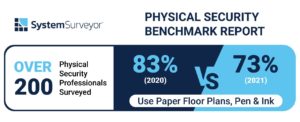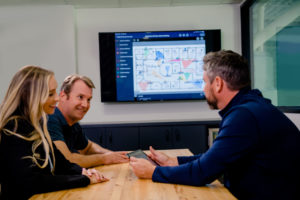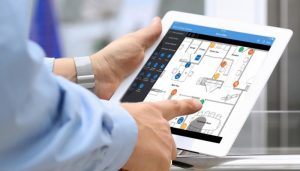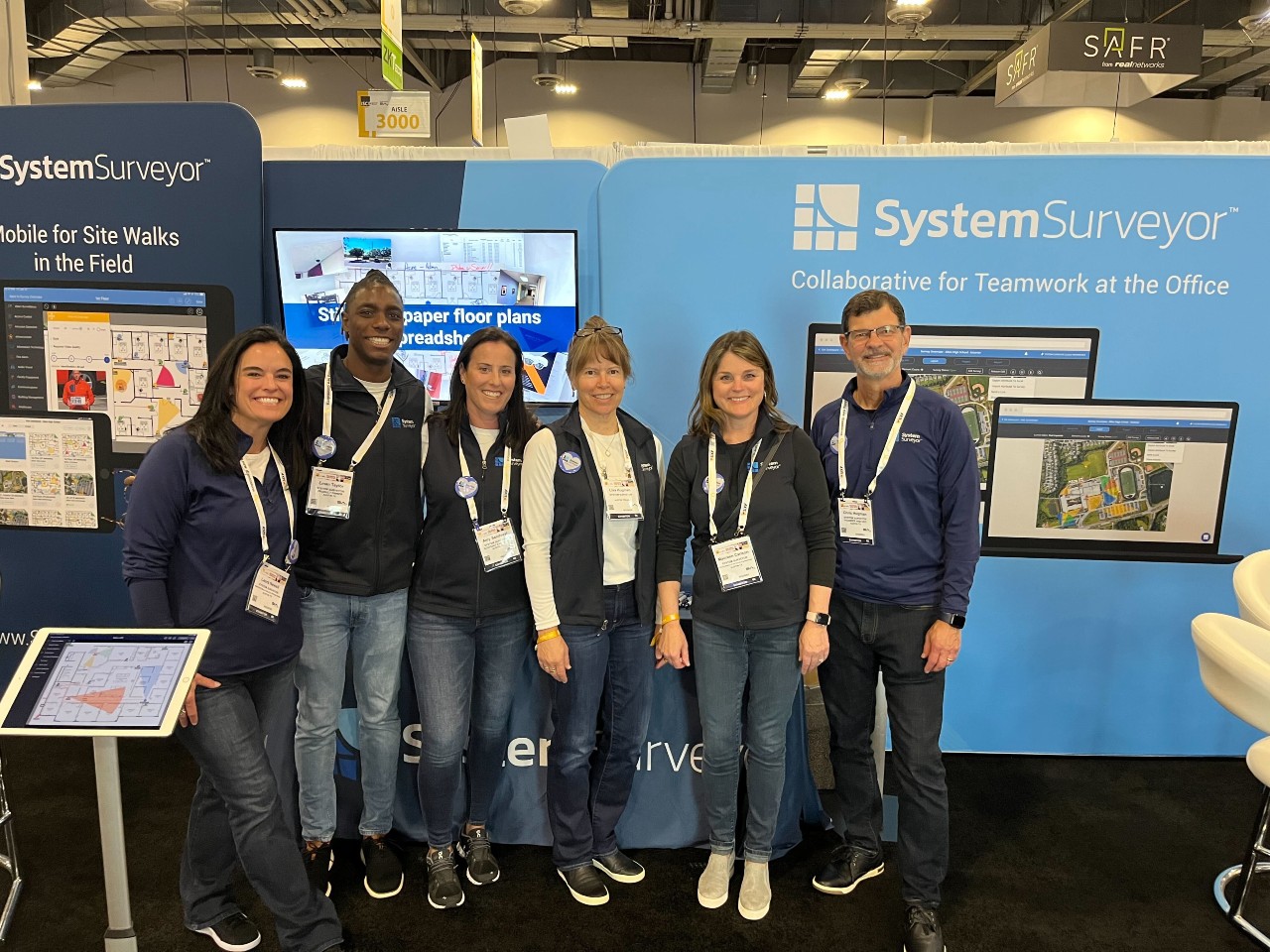The physical security industry is constantly evolving to meet the needs of today’s organizations and mitigate the security risks that threaten their buildings, assets, and personnel. As the industry evolves, it’s important for corporate and campus physical security leaders and system integrators alike to stay up to date on what’s changing.
The System Surveyor leadership team recently returned from ISC West 2022. The conference was excellent, providing insights from industry leaders as well as a place for us to hold conversations with members of our user community.
Today we’re sharing with you our observations on the state of the physical security industry and what the future of physical security looks like.
In this blog post, we’ll cover what’s changing in the physical security industry, along with what’s staying the same. And while we look ahead, we can also consider some of the opportunities and challenges we see from our lens.
What’s Changing
We came away from ISC West 2022 with six high-level observations of the most discussed physical security trends, giving some idea of what the future of the industry will look like:
- The cloud is no longer coming soon — it is now.
- Mobility and touchless reign, especially in access control.
- New technology such as Artificial Intelligence and machine learning is coming fast, and collaboration to tap into expertise is key.
- Digital transformation continues in the industry.
- Adoption of robots within physical security will increase.
- Customer experience is a growing focus in the industry.
Let’s briefly evaluate each of these observations.
1. The cloud is no longer coming soon — it is now
In recent years, other industries have been touting the cloud-based services as the solution to every problem, and hints of this have been happening around the edges of physical security as well. But today, the cloud is arriving in full force, with a host of newer video surveillance companies that lead with video recording to the cloud.
This is no longer a nascent technology, and it will become even more widespread over the coming years.
Yet even as recording to the cloud goes mainstream, the basics of security system design and physical camera placement remain as important as ever. System Surveyor’s powerful Camera Advisor feature can quickly determine the right camera and coverage area for every scenario, whether that camera records to the cloud or a more conventional storage method.
2. Mobility and Touchless reign, especially in access control
There continues to be heavy emphasis on touchless and mobile-first security measures, especially in the area of access control systems. Most of the major hospitality chains in the United States have started replacing traditional room keys with mobile credentials, and these technological advancements will quickly extend to college and corporate campuses.
The current pandemic-induced hybrid work model, where in certain spaces only certain employees are allowed on premises on a given day, has introduced its own set of potential risks and security concerns. Touchless systems and smart sensors increase convenience but don’t directly solve the increasingly complex access control needs of large campuses and businesses.
An access control system can be difficult to manage, budget, and install — but intelligent design tools can greatly reduce the difficulty.
3. AI, machine learning, and more are coming fast
Third, smart technology such as machine learning and deep learning are coming faster than the industry can keep up with. Innovations like predictive analytics have the potential to transform the physical security industry, allowing for greater efficiency and fewer false alarms, and collaboration to tap into the expertise to ensure that the use cases deliver on the promise is key.
Video analytics is at the forefront of this trend, utilizing machine learning and advanced algorithms to perform intelligent real-time monitoring that provides more intelligent data for security personnel and building managers. Facial recognition, motion detection, license plate recognition, object detection and tracking, and crowd management are just a few of the applications that benefit retail stores, healthcare facilities, schools, law enforcement departments, smart cities, and more.
Customers, vendors, integrators, and others will need to collaborate both to understand what these technologies are doing in the industry and to properly implement new tech-infused security systems and IoT devices. For many in the industry, there will be a significant learning curve and need for intelligent tools to help select the right solution.
4. Digital transformation continues, yet lags behind

Digital transformation — the process of moving analog processes into more powerful digital counterparts — continues to spread through the physical security industry, even if the pace is slower than in many other spaces.
We’re still seeing plenty of system integrators and end clients relying on paper floorplans marked up with pen and pencil, and emailing unsecure PDFs and sensitive data. In fact, there has been some progress – according to our new Benchmark Study of 200 physical security professionals, 73% as of November, 2021 are using paper and pen versus 83% in 2020 to design systems. There is plenty of room for that to grow. (Download our 2022 Physical Security Benchmark Report for more industry insights and findings.)
But solutions like System Surveyor are playing a pivotal role in the digital transformation of this industry, giving integrators the ability to capture digital requirements from the customer at the first point in the journey and carry that data through to an automated bill of materials and ultimately to a digital as-built at the end of the project. Also exciting is the digital collaboration between end users, integrators, subcontractors and others that are moving away from PDF markups and email to try to collaborate. Again, in the End User message to integrators, they are eager to get a portal or direct connection to their as-built and collaborate more deeply to get the job done.
We’re even seeing some clients use System Surveyor with drones’ imagery to create their own floorplans when they can’t access them a simpler way.
The future of the physical security industry, then, will involve the fusing of digital technology (including platforms like System Surveyor) with traditional methods of planning and documentation, where the result is a digital as-built with everything from the initial site survey to an accurate bill of materials, all in a central location that doesn’t get lost and allows for everyone involved to have quick remote access.
5. Adoption of robots within physical security will increase
On display at ISC West 2022 were numerous next-gen physical security robots. This tech is establishing a presence and will be seen more and more in the years to come. Look for newer models equipped with multiple or 360-degree cameras that can capture imagery as they patrol. Don’t be surprised to see this on your city streets, in the warehouse or the airport.
6. Customer experience has come to the physical security industry

Our last observation may be the most important: the concept of customer experience is gaining traction within physical security — and so are the roles and functions that go along with it.
More and more system integrators have a lead person responsible for the customer experience, rather than leaving customer experience up to sales and operations trying their best to coordinate.
That’s because there is a growing recognition that physical security sales aren’t a one-time operation. As devices grow more technologically complex, so does the customer journey. It’s no longer enough to sell a customer a set of technology and get it installed for them. Savvy integrators and Managed Service Providers (MSPs) are managing the customer journey and device lifecycles, tending to the customer experience in ways that simply didn’t happen a decade ago.
What does this look like for a forward-thinking system integrator or MSP? It starts with a seamless understanding from the sales process through delivery on what is expected and confirmation and documentation that the right solution has been delivered to the customer with great communication along the way. This proactive approach goes beyond just the sale and installation of the equipment and gets into the ongoing success of that equipment, along with paying attention to the lifecycle of security devices.
Here’s the gotcha for the customer experience: System integrators and solutions providers can’t deliver excellent customer experience unless they know exactly what’s in a client’s system, with data that’s detailed enough to highlight when various devices and products are reaching end of life.
That’s where System Surveyor comes in. System Surveyor is more than just a site planning tool — it’s a fully featured site management tool. Users can build out a system with far greater efficiency, based on their security concerns, in exceptionally high detail and in a visual format that makes it easy to track down exactly which devices are due for updates, and exactly where those devices are in a facility or campus.
With System Surveyor, forward-thinking integrators and physical security personnel gain the ability to see entire systems on a single pane of glass. Everyone — from subcontractors to customer stakeholders to vendors — sees the same information and can collaborate in real time. If you’re looking to supercharge customer experience efforts, this is a great place to start.
What Hasn’t Changed

While quite a bit is changing in the industry right now, our team also identified some core security needs that aren’t changing—and that aren’t going to change anytime soon. Giving the right amount of attention to these elements is more important than ever, even as organizations prepare for coming changes, too.
1. Relationships, collaboration, and communication remain essential
No amount of technological innovation can displace the need for relationships, collaboration, and communication in the physical security industry. These elements have always mattered, even if they aren’t always easy.
In fact, some new tech can enhance these efforts and allow for greater flexibility. One could say it is more important than ever to find new ways to visually collaborate with customers, vendors, and anyone else attached to a project, no matter where they are located. And with better visual design tools, all parties can communicate more precisely and foster better relationships.
2. The need for trust and confidence that security solutions can deliver
Going back to some of the elements that are changing, new tech in AI and machine learning is coming at a pace that feels too fast for integrators and security leaders to process. It’s easy to get pulled into a false sense of trust in what’s always worked — or to trust blindly that a new and unproven physical security solution will deliver on its promises.
This point comes back to customer experience and being a “trusted advisor”, as well: if a customer felt let down by a previous solution, their trust level is lower going into a new project. System integrators who can get in front of issues like those through proactive customer experience efforts will foster that trust and confidence — and reap numerous benefits.
3. The industry still needs systems and applications to integrate using open philosophy and APIs

We’ve included this under “what hasn’t changed” because the technology is already here — and it’s time for more industry players to adopt it. When systems work together seamlessly, we all benefit from easier technology and seamless interactions between systems.
While APIs and open architecture are here, we know that there is a way to go to connect the dots everywhere. Keep this goal in mind and work with your software providers, manufacturer partners and others to keep pushing to advance this important evolution. One great example are the inspiring manufacturers who are part of the System Surveyor Manufacturer program, they make their catalogs and element profiles available to any user to drag, drop and automate the bill of materials. Invite your favorite manufacturer to the party!
4. There’s still a gap between companies and best-fit providers, especially globally: bring subcontracts into the fold digitally
Not all companies have security professionals in every location where they have facilities. Similarly, not all systems integrators have team members on site in every location where their clients have property.
This creates a natural gap between companies and best-fit providers: a company’s physical security leaders may be located states—or even countries—away from where a local subcontractor is executing an install.
While subcontractors have been in the industry for decades, new opportunities exist to have them collaborate in a digital, efficient way that lets them be your eyes, ears and hands in remote locations. But beware of trying to do this with email – it’s not scalable.
I’m sure we did not cover everything about this exciting future but we know that we want to be an important part of your opportunity to capitalize on the exciting opportunities.
System Surveyor is an ideal cloud-based solution for every system integrator, physical security leader, and vendor serving the industry—especially for those who want to navigate the coming industry changes.
Ready to try it for yourself? Try System Surveyor free today!
